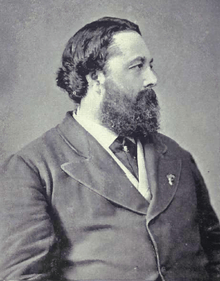Thomas Sterry Hunt
| Thomas Sterry Hunt | |
|---|---|
 | |
| Born |
September 5, 1826 Norwich, Connecticut |
| Died |
February 12, 1892 (aged 65) New York City |
| Occupation | geologist, chemist |
Thomas Sterry Hunt (September 5, 1826 – February 12, 1892) was an American geologist and chemist.
Biography
Hunt was born at Norwich, Connecticut. He lost his father when twelve years old, and had to earn his own livelihood. In the course of two years he found employment in a printing office, in an apothecary shop, in a book store and as a clerk. He became interested in natural science, and especially in chemical and medical studies, and in 1845 he was elected a member of the Association of American Geologists and Naturalists at Yale – a body which four years later became the American Association for the Advancement of Science.
In 1848 he read a paper in Philadelphia On Acid Springs and Gypsum Deposits of the Onondaga Salt Group.[1] At Yale he became assistant to Benjamin Silliman Jr., and in 1846 was appointed chemist to the Geological Survey of Vermont. In 1847 he was appointed to similar duties on the Canadian Geological Survey at Montreal under Sir William Logan, and this post he held until 1872. He resigned to become professor of geology at Massachusetts Institute of Technology. He was elected a Associate Fellow of the American Academy of Arts and Sciences in 1851.[2]
In 1859 he was elected fellow of the Royal Society, and he was one of the original members and president of the Royal Society of Canada. He was made Chevalier or the Legion of Honor in France and an honorary doctor of laws of the University of Cambridge. He was a frequent contributor to scientific journals, writing on the crystalline limestones, the origin of continents, the chemistry of the primeval earth, on serpentines, etc. He also wrote a notable Essay on the History of the names Cambrian and Silurian (Canadian Naturalist, 1872), in which the claims of Adam Sedgwick, with respect to the grouping of the Cambrian strata, were forcibly advocated. Hunt was elected a member of the National Academy of Sciences in 1873.[3]
Building upon John Tyndall's research on greenhouse gases, Hunt first proposed the theory which linked climate change from the Carboniferous to the modern age to concentrations of carbon dioxide in the atmosphere in an 1863 submission to the American Journal of Science and Arts.[4] He further explored at a meeting for the British Society for the Advancement of Science in the fall of 1878. This was well before Arrhenius established the theory of the greenhouse effect. Hunt later hypothesized that the high concentrations of atmospheric carbon dioxide in the geologic past was of cosmic, rather than volcanic, origin.[5]
He died in New York City on February 12, 1892. The Thomas-Sterry-Hunt International Ecological Reserve, an ecological reserve in Quebec, Canada was established on September 7, 1988.
Publications
| Library resources about Thomas Sterry Hunt |
| By Thomas Sterry Hunt |
|---|
His publications include:
- Chemical and Geological Essays (1875, ed. 2, 1879)
- Mineral Physiology and Physiography (1886)
- A New Basis for Chemistry (1887, ed. 3, 1891)
- Systematic Mineralogy (1891)
Organizations of which he was president
- American Association for the Advancement of Science (1870)
- American Institute of Mining Engineers (1876)
- American Chemical Society (1879 and 1888)
- Royal Society of Canada (1884)
Family

In January, 1878, Thomas Sterry Hunt married Anna Rebecca, daughter of Mr. Justice Gale, of Montreal. She was born and educated in Montreal, Quebec. Her early years were spent on a farm adjacent to Montreal. After her father's death, in 1865, she and her two sisters, Baroness von Friesen, and Mrs. Stuart of Quebec, travelled extensively in Europe. The couple moved to Boston, and travelled extensively both before and after her husband's death in February, 1892. Mrs. Hunt was a linguist, and authored volumes of poems.[6]
References
- ↑ Frazer, Persifor (1893). "Thomas Sterry Hunt". The American Geologist. 11 (1): 1–13. Retrieved 22 August 2016.
- ↑ "Book of Members, 1780–2010: Chapter H" (PDF). American Academy of Arts and Sciences. Retrieved September 11, 2016.
- ↑ "T. Sperry Hunt". National Academy of Science. Retrieved September 11, 2016.
- ↑ Hunt, T. Sterry (November 1863). "On the Earth's Climate in Paleozoic Times". American Journal of Science and Arts. 36 (108): 396.
- ↑ Hunt, T. Sterry. "ART. XLIII.--The Chemical and Geological Relations of the Atmosphere". American Journal of Science. 19 (113): 349.
- ↑ Morgan, Henry James (1903). Types of Canadian women and of women who are or have been connected with Canada. Toronto: William Briggs. p. 169. Retrieved 22 August 2016.
-
 This article incorporates text from a publication now in the public domain: Chisholm, Hugh, ed. (1911). "Hunt, Thomas Sterry". Encyclopædia Britannica (11th ed.). Cambridge University Press.
This article incorporates text from a publication now in the public domain: Chisholm, Hugh, ed. (1911). "Hunt, Thomas Sterry". Encyclopædia Britannica (11th ed.). Cambridge University Press.
External links
-
 Works written by or about Thomas Sterry Hunt at Wikisource
Works written by or about Thomas Sterry Hunt at Wikisource - Biography at the Dictionary of Canadian Biography Online
- National Academy of Sciences Biographical Memoir
| Professional and academic associations | ||
|---|---|---|
| Preceded by Pierre-Joseph-Olivier Chauveau |
President of the Royal Society of Canada 1884–1885 |
Succeeded by Daniel Wilson |